Sizing Parts By Hand
I hope you will indulge me this post as I had a rather proud moment the other night in my shop. I shared a little of it via Twitter and I thought it might be good to put it down here as well.
Sizing project parts and panels to exact and identical sizes entirely by hand is really very rewarding. It doesn’t get talked about much as it isn’t a sexy task. It’s ironic because having your project parts to the right, and sometimes identical, sizes is key to building a cabinet or table before even starting the joinery. It is as fundamental a skill as flattening the boards in the first place.
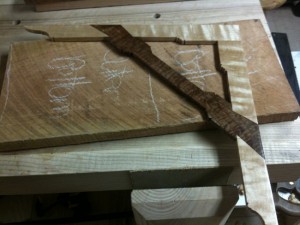 So here I am in my shop with a few rough pieces of stock that need to be made into a cabinet carcass. I enjoy hand milling my stock but I try to stack the cards in my favor by removing most of the cup and bow with the saw. I start with my layout square and strike a line with pencil or lumber crayon about 1/2″ proud of my needed length.
So here I am in my shop with a few rough pieces of stock that need to be made into a cabinet carcass. I enjoy hand milling my stock but I try to stack the cards in my favor by removing most of the cup and bow with the saw. I start with my layout square and strike a line with pencil or lumber crayon about 1/2″ proud of my needed length.
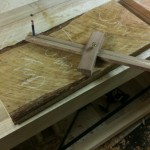 Then I use a panel gauge with a pencil head to mark the width within 3/4″ to 1″. I find a little extra room is needed here as side bend and variation in the rough sawn edge requires it. You could quickly joint the edge first to get a more accurate mark, but I’m working at a very rough stage at this point.
Then I use a panel gauge with a pencil head to mark the width within 3/4″ to 1″. I find a little extra room is needed here as side bend and variation in the rough sawn edge requires it. You could quickly joint the edge first to get a more accurate mark, but I’m working at a very rough stage at this point.
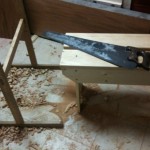 With some basic crayon marks on the board, I crosscut and rip it to my marked lines at the sawbench. I use my shop bent as an “outfeed” support of sorts as well. I find this really helpful when ripping as I can scoot the board along the bench thus keeping the cut line right beneath me and allowing my body to relax and make a square and plumb cut.
With some basic crayon marks on the board, I crosscut and rip it to my marked lines at the sawbench. I use my shop bent as an “outfeed” support of sorts as well. I find this really helpful when ripping as I can scoot the board along the bench thus keeping the cut line right beneath me and allowing my body to relax and make a square and plumb cut.
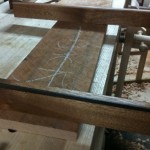 Back up at the bench, winding sticks are utilized to take stock of the board and see what kind of cup, bow, and twist I still have left to plane away. With the unnecessary stock sawn away, much of these elements are already gone so the actual flattening is really easy. I flip the board, gauge my thickness and plane to that line.
Back up at the bench, winding sticks are utilized to take stock of the board and see what kind of cup, bow, and twist I still have left to plane away. With the unnecessary stock sawn away, much of these elements are already gone so the actual flattening is really easy. I flip the board, gauge my thickness and plane to that line.
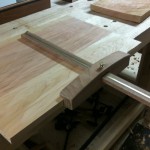 Now I’m left with a pretty panel that has usually one jointed edge and two flat, parallel faces. The whole panel is usually within 1/2″ of my finished sizes. Now I’ll go back with my layout square and pencil in a square end. Saw to it, then plane to clean up. The layout square is used again to set another square end but this time I want to set it to my desired finished length so I will use a knife to mark the line. I saw and plane again right to the line. Finally, I used a panel gauge equipped with a knife edge to mark a parallel edge exactly on my finished width. Saw and/or plane to that line and voila! One perfectly sized, flat and square on 6 sides board ready for joinery.
Now I’m left with a pretty panel that has usually one jointed edge and two flat, parallel faces. The whole panel is usually within 1/2″ of my finished sizes. Now I’ll go back with my layout square and pencil in a square end. Saw to it, then plane to clean up. The layout square is used again to set another square end but this time I want to set it to my desired finished length so I will use a knife to mark the line. I saw and plane again right to the line. Finally, I used a panel gauge equipped with a knife edge to mark a parallel edge exactly on my finished width. Saw and/or plane to that line and voila! One perfectly sized, flat and square on 6 sides board ready for joinery.
It seems silly because people do this every day with table saws and chop saws to easily size their stock. Doing it by hand does take longer no doubt, but no matter how many times I do it I feel a little triumph. I’ll run a square around the board reveling in the exactness of each edge. A check with a ruler shows no deviation in length and width. I essentially have a perfect parallelogram created from a rough board. Maybe it is OCD, but there is something very satisfying about it.
So certainly I am proud of my ability to create this perfect board. However what got me really excited is that after I had created this perfect board I realized that all of the shop appliances and gauges I used I had made myself. In fact, they were all projects used to apply skills taught as part of my first semester course in my Hand Tool School.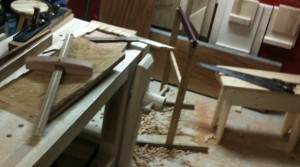 This is where it may seem like blatant self promotion, but I can honestly say that I was really proud that I had created something that taught others how to build by hand and then showed them how to make tools that would help them work even more accurately and efficiently by hand. And here was my proof: a perfectly sized Cherry case panel that had only been touched by hand tools.
This is where it may seem like blatant self promotion, but I can honestly say that I was really proud that I had created something that taught others how to build by hand and then showed them how to make tools that would help them work even more accurately and efficiently by hand. And here was my proof: a perfectly sized Cherry case panel that had only been touched by hand tools.
- Sawbench: Lesson 2 on Sawing Fundamentals
- Shop Bent: Lesson 6 on Mortises & Tenons
- Layout Square: Lesson 5 on Half Laps
- Panel Gauge: Lesson 12 on Building by Hand w/o A Plan
- Winding Sticks: Lesson 1 on Setting Up Shop and Planing
So if you are already a member of the School, thank you very much for supporting my efforts and I hope you get as much a thrill as I do about such a simple task. If you are not a member, then this is just a peek into what has been keeping me busy for the last 6 months. So far this semester I have published over 30 hours of video content and each moment has been a thrill to create.


